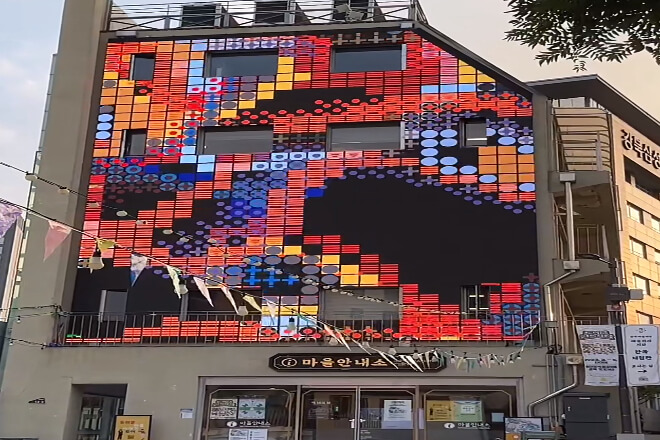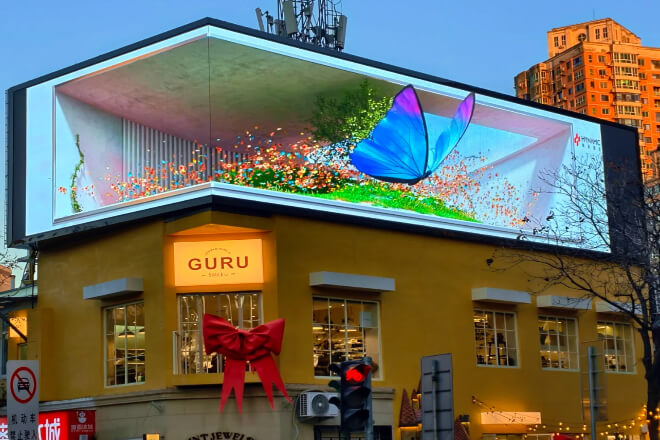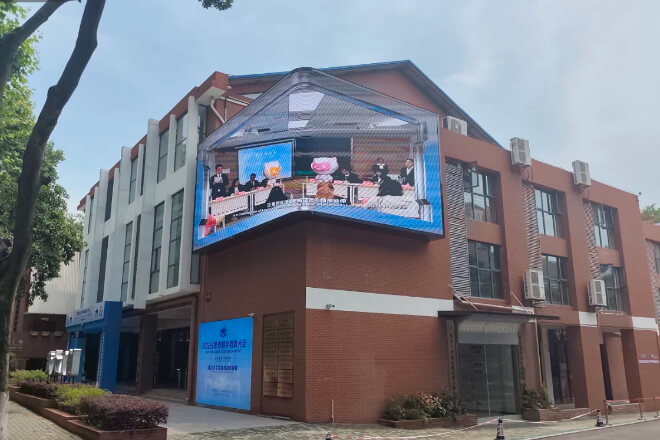Introduction
Imagine that those ancient buildings, after years of baptism, can also be rejuvenated with the help of modern technology.
Can Écrans d'affichage LED, the crystallization of modern technology, bring new vitality and value to old buildings? This article will take you to find out.
Table des matières
1. Analysis of the compatibility of old building renovation and LED display screens

Old buildings are witnesses of history and have unique stories. LED display screens are like a magical “story machine” that can tell everyone the history and culture behind the building with vivid pictures and animations.
For example, the Louvre uses LED display screens on the exterior wall to display artworks and exhibition information in the museum.
Allowing tourists to have a deeper understanding of art and culture while appreciating ancient buildings.
This combination not only makes old buildings “come alive” but also makes cultural inheritance more vibrant and better protects and disseminates cultural heritage.
Although old buildings have charm, they inevitably look old. Once the LED display screen is installed, it is like “makeup” for the old building, making it sparkle at night, which is particularly attractive.
Moreover, the design of the display screen can be customized according to the style of the old building, which not only retains the ancient charm but also adds a modern feel。
Making the old building visually brand new and becoming a beautiful landscape in the city night scene.
The LED display screen is a “commercial weapon” for old buildings. It can be used as an advertising space to attract businesses to place advertisements and bring advertising revenue to the building owners.
After the old buildings in the commercial district were installed, they immediately became popular advertising spaces, and their commercial value increased significantly.
After the renovation of abandoned factories and old shopping malls, they can also attract people, drive the development of surrounding businesses, and achieve a gorgeous transformation of commercial value.
Economically, the LED display screens after the renovation of old buildings bring advertising revenue, rent growth, sales growth, etc., which promotes local economic development.
Socially, it enriches the cultural life of citizens, enhances the image of the city, drives the development of tourism.
Shows the perfect combination of technology and culture. And injects new impetus into the sustainable development of the city.
2. Application scenarios of LED display screens in the renovation of old buildings

1). Commercial space renovation
In the renovation of old commercial buildings, LED display screens are widely used, mainly for advertising display, brand promotion, and enhancing the business atmosphere.
For example, Shanghai CITIC Square used glass curtain walls and LED display screens of various shapes in the renovation.
Through customized display solutions, green energy-saving technology, and modern information technology, a transparent, diverse, and interactive urban picture was created.
This renovation not only improves the visual effect of the building but also enhances the business atmosphere and attracts more consumers.
Another successful case is Beijing 798 Art District, where LED display screens are installed on the exterior walls of some abandoned factories to play dynamic advertisements and creative art installations, attracting a large number of people.
This renovation not only enhances the visibility and influence of commercial space but also promotes the development of the local economy.
2). Cultural and art space renovation
In the renovation of old musées, theaters, art galleries, and other cultural buildings, LED display screens significantly enhance the cultural display effect and enhance the audience experience.
For example, the “Colorful Sydney” light show held by the Sydney Opera House every year uses LED display screens and lighting technology.
Transforming the building surface into a huge art canvas has attracted more than 1 million visitors and brought more than 20 million Australian dollars in revenue to the local area.
In addition, the “INSIDEOUT” project of the Bauhaus University Library in Weimar, Germany.
Not only beautifies the appearance of the building but also enhances the public’s perception of the building by displaying media content on the building facade.
3). Renovation of public spaces and urban landmarks
In the renovation of public spaces such as old city squares and historical blocks, LED display screens, as part of the urban landscape, can significantly enhance the city’s image.
Par exemple, le naked-eye 3D large screen in Chengdu Taikoo Li has created a new paradigm for spatial narrative in commercial streets.
Bringing an immersive visual experience to the audience through multi-viewpoint rendering technology and a directional sound field system.
This innovative application not only enhances the attractiveness of public spaces but also promotes the development of the night economy.
In the renovation of urban landmark buildings, LED display screens show urban culture through light and shadow effects.
For example, the LED light show in Chongqing Hongyadong extends the operating time of the commercial street by 3 hours.
The LED light strips on the building facade are perfectly integrated with the stilt building structure, and global linkage is achieved through the central control system.
This transformation not only improves the visual effect of the city landmark but also enhances the cultural atmosphere of the city.
3. Economic and environmental benefit analysis of LED display screens in the renovation of old buildings

1). Economic cost and benefit evaluation
Let’s talk about the cost first. Installing an LED display screen costs a lot of money at the beginning, including buying equipment, installation, and subsequent maintenance.
However, despite its high initial investment, it can save you a lot of money in the long run. LED display screens can be used for many years, unlike some equipment that has to be replaced after a short period of use.
Moreover, it is very durable, earthquake-resistant, waterproof, not afraid of wind and rain, and easy to maintain.
Let’s talk about the benefits. LED display screens can double your advertising effect. It has high luminosité, clear pictures, and a dynamic display, which can attract more people’s attention.
In this way, your advertising can reach target customers more effectively and enhance commercial value. Moreover, LED display screens can also help you save electricity.
Many businesses have found that energy costs can be reduced by about 30% on average after using LED display screens.
From the perspective of advertising revenue, LED display screens are simply “money-making artifacts.”
It can be used as an advertising space to attract businesses to place advertisements, bringing considerable advertising revenue to the building owner.
For example, some old commercial buildings in Paris were equipped with LED screens to play dynamic advertisements and creative art installations, attracting a large number of people and greatly improving their commercial value.
2). Environmental sustainability considerations
Let’s look at the environmental benefits. LED screens are particularly energy-saving, and their electro-optical conversion efficiency is high, and most of the electrical energy can be converted into light energy.
Moreover, their service life is particularly long, and they can be used for tens of thousands of hours or even hundreds of thousands of hours.
This means that during the service life, you don’t have to frequently replace the equipment, reducing the generation of electronic waste.
LED screens are also particularly environmentally friendly and do not contain harmful substances such as mercury. Most of its materials can be recycled and reused, reducing resource waste.
For example, many of its shells and packaging materials are aluminum, which are easy to recycle and are particularly friendly to the environment.
4. Precautions for LED screens in the renovation of old buildings

1). Structural adaptability issues
The “skeleton” of old buildings and the “weight” of LED screens are sometimes not well matched.
For example, old buildings may not be very strong and have limited load-bearing capacity, and LED screens also have a certain weight.
Also, the space in old buildings may be relatively compact, leaving insufficient space for display screen installation.
If these problems are not solved, the display screen may be shaky when installed or even pose a safety hazard.
The solution is also very simple. First, you need to carefully check the structure of the old building to see where it needs to be reinforced.
For example, if the load-bearing capacity is insufficient, you can add a few support columns or use stronger materials to disperse the weight.
For the problem of insufficient space, you can design a suitable display screen shape and installation location according to the specific conditions of the old building.
It’s like tailoring a new piece of clothing for the old building, which is both beautiful and practical.
2). Integration of electrical and system lighting
The wires and circuits of old buildings may be relatively old and may not meet the power supply and heat dissipation requirements of LED display screens.
LED display screens require a stable power supply, and they will generate heat during operation, requiring good heat dissipation.
If the electrical system is not good, the display screen may malfunction or even cause a fire.
To solve this problem, you have to upgrade the electrical system of the old building. For example, add a new power supply line and install a voltage stabilizer to ensure a stable power supply.
You can also install a heat dissipation device to prevent the display screen from overheating during operation.
At the same time, an intelligent lighting control system can be installed to connect the display screen to the building’s lighting system.
In this way, the brightness and lighting effect of the display screen can be automatically adjusted according to different times and scenes, which is both energy-saving and convenient.
3). Compatibility of data transmission and control system
The communication system of the old building may be relatively backward and not compatible with the data transmission and control system of the LED display screen.
This may cause the display screen to not receive data or the remote control function to be difficult to use.
The solution is to use advanced communication technology and control systems. For example, wireless communication or optical fiber communication can be used to ensure fast and stable data transmission.
You can also use a distributed control system to disperse the control function of the display screen to multiple places.
In this way, even if there is a problem somewhere, it will not affect the entire system. Moreover, the remote control function can make operation and maintenance more convenient.
5. Conclusion
Through the discussion in this article, do you have a new understanding of the application of LED display screens in the renovation of old buildings?
From cultural heritage to commercial value-added, from visual effects to environmental sustainability, LED display screens bring unlimited possibilities to old buildings.
Enfin, si vous souhaitez en savoir plus sur les écrans d'affichage LED, veuillez nous contacter.
